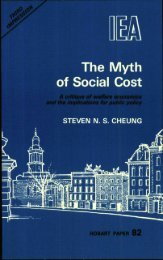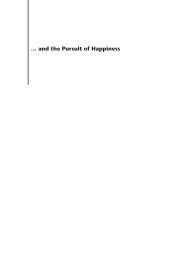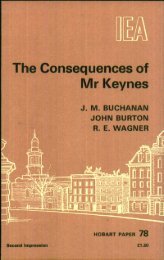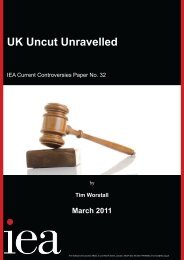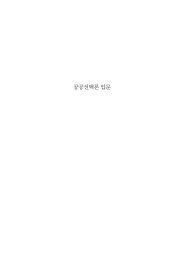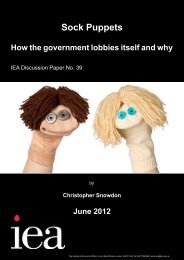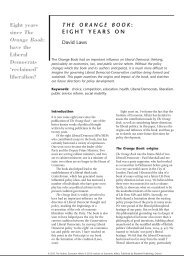Hayek's The Constitution of Liberty - Institute of Economic Affairs
Hayek's The Constitution of Liberty - Institute of Economic Affairs
Hayek's The Constitution of Liberty - Institute of Economic Affairs
Create successful ePaper yourself
Turn your PDF publications into a flip-book with our unique Google optimized e-Paper software.
6 THE RULE OF LAW AND ITS<br />
DETRACTORS (Chapters 14 and 16)<br />
Hayek’s primary aim in <strong>The</strong> <strong>Constitution</strong> <strong>of</strong> <strong>Liberty</strong> is to explain<br />
the meaning and practical significance <strong>of</strong> the Rule <strong>of</strong> Law. Part II,<br />
where this ideal is portrayed, is the book’s centre, both literally<br />
and substantively.<br />
Hayek had <strong>of</strong>ten spoken <strong>of</strong> the Rule <strong>of</strong> Law in earlier writings<br />
(see 1944b [2007b]: 112–23), but his fullest account, prior to <strong>The</strong><br />
<strong>Constitution</strong> <strong>of</strong> <strong>Liberty</strong>, appears in a set <strong>of</strong> four lectures, delivered<br />
in 1955 at the invitation <strong>of</strong> the Bank <strong>of</strong> Egypt, entitled <strong>The</strong> Political<br />
Ideal <strong>of</strong> the Rule <strong>of</strong> Law (1955). Later, Hayek explains that while en<br />
route to Egypt, he and his wife spent several months in Europe,<br />
retracing a journey that J. S. Mill had once made to Italy and<br />
Greece. <strong>The</strong> trip rekindled Hayek’s interest in Mill’s On <strong>Liberty</strong><br />
and its case for freedom. <strong>The</strong> Cairo Lectures, together with his<br />
‘constant preoccupation with Mill’s thinking,’ brought it about<br />
that after Hayek returned to Chicago in the autumn <strong>of</strong> 1955, ‘the<br />
plan for <strong>The</strong> <strong>Constitution</strong> <strong>of</strong> <strong>Liberty</strong> suddenly stood clearly before<br />
my mind … I had before me a clear plan for a book on liberty<br />
arranged round the Cairo lectures’ (1994: 129–30). In this light, we<br />
see that Part I <strong>of</strong> <strong>The</strong> <strong>Constitution</strong> <strong>of</strong> <strong>Liberty</strong> takes up questions <strong>of</strong><br />
individual freedom that Mill wrestled with, but failed to resolve<br />
satisfactorily. Part II restates and expands the Cairo Lectures. Part<br />
III applies the Rule <strong>of</strong> Law to issues <strong>of</strong> government policy. Hayek<br />
drew heavily from the Cairo Lectures in preparing <strong>The</strong> <strong>Constitution</strong><br />
101



